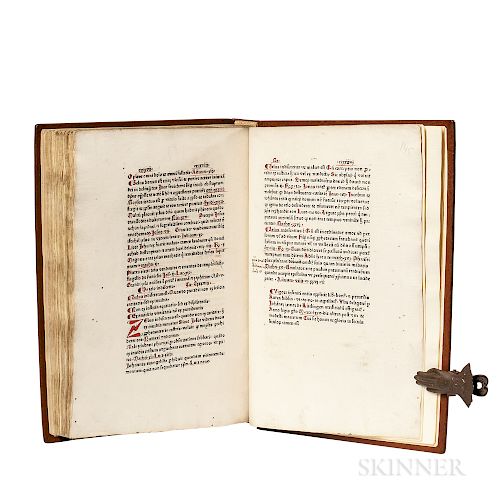Rampigollis, Antonius (dates unknown) and Bindo de Senis (d. 1390) Aurea Biblia, sive Repertorium Aureum Bibliorum.
Lot 193
About Seller
Bonhams Skinner
274 Cedar Hill Street
Marlborough, MA 01752
United States
Founded over four decades ago, Bonhams Skinner offers more than 60 auctions annually. Bonhams Skinner auctions reach an international audience and showcase the unique, rare, and beautiful in dozens of categories, including the fine and decorative arts, jewelry, modern design, musical instruments, sc...Read more
Categories
Estimate:
$6,000 - $8,000
Absentee vs Live bid
Two ways to bid:
- Leave a max absentee bid and the platform will bid on your behalf up to your maximum bid during the live auction.
- Bid live during the auction and your bids will be submitted real-time to the auctioneer.
Bid Increments
| Price | Bid Increment |
|---|---|
| $0 | $10 |
| $100 | $25 |
| $500 | $50 |
| $1,000 | $100 |
| $3,000 | $250 |
| $5,000 | $500 |
| $10,000 | $1,000 |
| $30,000 | $2,500 |
| $50,000 | $5,000 |
| $100,000 | $10,000 |
| $300,000 | $25,000 |
| $500,000 | $50,000 |
| $1,000,000 | $100,000 |
About Auction
By Bonhams Skinner
Jul 23, 2019
Set Reminder
2019-07-23 11:00:00
2019-07-23 11:00:00
America/New_York
Bidsquare
Bidsquare : A Mystic Collection: Early Books
https://www.bidsquare.com/auctions/skinner/a-mystic-collection-early-books-4257
This sale is a single-owner collection featuring early books with an emphasis on incunabula, devotional manuscripts (text and illuminated), illustrated works, and fine bindings, both continental and English, with a subset of classics, emblem books, and a copy of the Nuremberg Chronicle. Bonhams Skinner bidsquare@bonhamsskinner.com
This sale is a single-owner collection featuring early books with an emphasis on incunabula, devotional manuscripts (text and illuminated), illustrated works, and fine bindings, both continental and English, with a subset of classics, emblem books, and a copy of the Nuremberg Chronicle. Bonhams Skinner bidsquare@bonhamsskinner.com
- Lot Description
Rampigollis, Antonius (dates unknown) and Bindo de Senis (d. 1390) Aurea Biblia, sive Repertorium Aureum Bibliorum. Ulm: Johann Zainer, 17 June 1475 [ISTC]. Editio princeps; the colophon reads "die altera post viti & modesti martirum," (15 June), Goff gave the date as 16 June; prologue only by Antonius Rampigollis, text by Bindo of Siena; 159 of 160 leaves, lacking the final blank (first blank present), single column throughout, gothic typeface, initials, capital strokes, and paragraph marks in red throughout, printed woodcut initials highlighted in red; some contemporary marginal notes; some manuscript ink signature marks visible; owner inscriptions of Johannes Werder dated 1495 and Brother Wolfgang Sedel dated 1536 "et iam me comparavit in foro publico," to first leaf of text; some worming; bound in full brown morocco by Anthony Gardner in 1968, with his full page Apologia on back binder's flyleaf; early ink title to bottom page edges, 11 1/4 x 8 in.
This popular and utilitarian text, filled with practical biblical allegories, was meant to provide help and advice to the Christian layman on topics from abstinence to zeal (subjects are arranged alphabetically). After going through twelve incunabula editions in twenty years, Pope Clement VIII (1536-1605) placed the Aurea Biblia on the index of prohibited books (Index Librorum Prohibitorum), citing the author's propensity to misquote the Bible and indulge in wild stories from questionable authors.
[*8, **6, a-b10, c8, d-o10, p8].
Goff R12; HC 13681*; Pell Ms 9971 (9762); CIBN R-11; IBE 1068; IGI VI 1736-A; Bod-inc B-345B; Sheppard 1799; Pr 2508; BMC II 524; BSB-Ink B-520; GW M36970.
Estimate $6,000-8,000
Items may have wear and tear, imperfections, or the effects of aging. Any condition statement given, as a courtesy to a client, is only an opinion and should not be treated as a statement of fact. Skinner shall have no responsibility for any error or omission. - Shipping Info
-
Please visit http://www.skinnerinc.com/services/payment-and-shipping/ for information regarding the collection of items purchased at auction.
-
- Buyer's Premium



 EUR
EUR CAD
CAD AUD
AUD GBP
GBP MXN
MXN HKD
HKD CNY
CNY MYR
MYR SEK
SEK SGD
SGD CHF
CHF THB
THB











